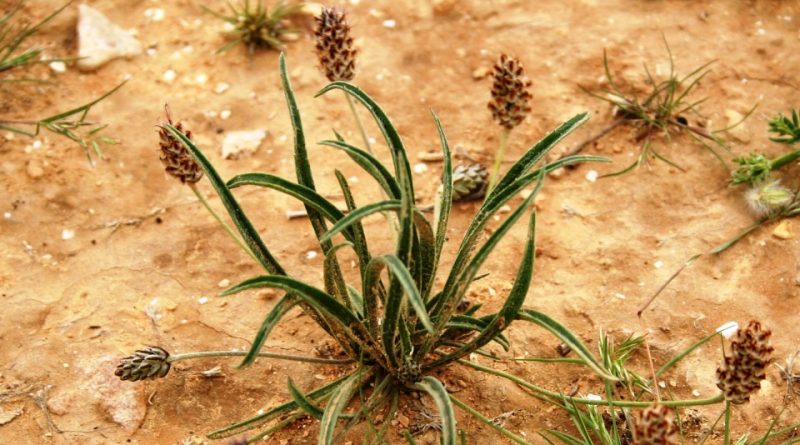Plantago ovata
Plantago ovata
Blond plantain or desert Indianwheat or blond psyllium or ispagol (Plantago ovata Forssk.) is a herbaceous species belonging to the Plantaginaceae family.
Systematics –
From a systematic point of view it belongs to:
Eukaryota Domain,
Kingdom Plantae,
Magnoliophyta Division,
Magnoliopsida class,
Plantaginales Order,
Plantaginaceae family,
Genus Plantago,
P. ovata species.
The terms are synonymous:
– Plantago brunnea Morris;
– Plantago decumbens Bernh. ex Rchb .;
– Plantago fastigiata Morris;
– Plantago gooddingii A. Nels. & Kennedy;
– Plantago insularis Eastw .;
– Plantago ispaghula
– Plantago minima A. Cunningham ..
Etymology –
The term Plantago comes from plánta sole of the foot: similar to the sole of the foot, referring to the size of the leaves of the greater plantain.
The specific epithet ovata means egg-shaped, from óvum egg due to the presence of ovate-shaped organs or structures.
Geographic Distribution and Habitat –
Plantago ovata is a medicinal plant native to an area ranging from the Mediterranean to western and southern Asia but present in Europe, in the Mediterranean up to East Asia and India.
Its habitat is that of open and often dry or arid places.
Description –
Plantago ovata is an annual herbaceous plant, which normally grows up to 20-40 cm, with leaves that branch off from the rosette base.
The leaves are consistent, dark in color, curved on the main axis, lanciform, with the presence of small thorns along the margin.
The flowers are collected in inflorescences that branch off from the base.
Each ear is cylindrical, tight, 2-8 cm long, which reaches 15 cm in fruiting. The flowers have a corolla about 4 mm long, tubular, compressed, glabrous, with 4 whitish, enlarged, ovate-acute lobes. The stamens are protruding, with white anthers.
The fruit is a glabrous, ovoid capsule (pyxidium), 3-4 x 2-2.5 mm, with (2) 4 (6) hemiellipsoid seeds with flat internal face, brown, of 1.8-2.2 x 0.8-1 mm.
Cultivation –
Plantago ovata is an annual plant that is harvested in nature for local use as a food, medicine and source of materials.
This plant, as a rule, is not cultivated except in India, and some other areas, where cultivation is carried out for the production of the seed.
In general, however, it is a plant that grows in many types of soil, even moderately fertile, in a sunny position.
Propagation takes place by seed which must be sown in spring both in seedbeds and in broad field.
If sowing is done in the nursery, when the seedlings have reached the size that they can be handled, they must be transplanted into individual pots where they must be grown until the final transplant, in the open field, in mid-spring.
Customs and Traditions –
Plantago ovata is mainly used as a source of seed husks used as dietary fiber, and also for medicinal purposes.
Psyllium seed husks are indigestible and are a source of soluble fiber that can be fermented into butyrate – a pharmacologically active short-chain fatty acid – by butyrate-producing bacteria.
Among the edible uses it should be remembered that the young leaves can be eaten both raw and cooked.
The mucilage contained in the integument is used as a stabilizer in ice cream, chocolate, etc.
Sprouted seeds are eaten in salads.
For medicinal use it has been used for thousands of years as a safe and effective laxative in Western herbal medicine.
Both dried seeds and seed shells are emollients and laxatives. They are used in the treatment of dysentery, catarrhal conditions of the genitourinary tract, inflamed membranes of the intestinal canal, etc.
The seeds have a mucilaginous coating and swell up to several times their volume when immersed in water.
The seeds and skins contain high levels of fiber, expand and become highly gelatinous when immersed in water. By maintaining a high water content within the large intestine, they increase the mass of stool, facilitating its passage.
For this they are used as an emollient and as a mass laxative in the treatment of constipation, dysentery and other intestinal disorders, having a calming and regulatory effect on the system.
Their regulating effect on the digestive system means that they can also be used in the treatment of diarrhea and by helping to soften the stool they reduce the irritation of hemorrhoids.
The gelatinous mucilage produced when psyllium is immersed in water has the ability to absorb toxins within the large intestine. Hence it helps remove toxins from the body and can be used to reduce self-toxicity.
The oil present in the seed embryo contains 50% linoleic acid and has been used as a preventative of atherosclerosis.
It is also effective in lowering blood cholesterol levels.
Among other uses it should be remembered that a mucilage found in the integument is sometimes used as a starch to stiffen the linen.
Preparation Method –
Plantago ovata is a plant that is used both in the food field and as a medicinal herb.
The young leaves can be eaten both raw and cooked while the sprouted seeds are eaten in salads.
The mucilage contained in the integument is used to stabilize ice cream, chocolate, etc.
In the medicinal field it has been used for thousands of years as a safe and effective laxative in Western herbal medicine, using the property of seeds to significantly increase the volume when immersed in water.
Guido Bissanti
Sources
– Acta Plantarum – Flora of the Italian Regions.
– Wikipedia, the free encyclopedia.
– Useful Tropical Plants Database.
– Conti F., Abbate G., Alessandrini A., Blasi C. (ed.), 2005. An annotated checklist of the Italian vascular flora, Palombi Editore.
– Pignatti S., 1982. Flora of Italy, Edagricole, Bologna.
– Treben M., 2000. Health from the Lord’s Pharmacy, Advice and experiences with medicinal herbs, Ennsthaler Editore.
Photo source: https://flora.org.il/en/plants/PLAOVA/
Warning: Pharmaceutical applications and alimurgical uses are indicated for informational purposes only, they do not represent in any way a medical prescription; therefore no responsibility is taken for their use for curative, aesthetic or food purposes.


